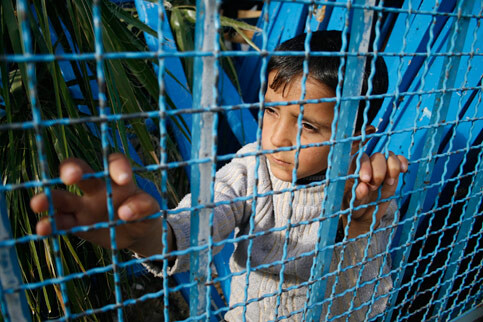The Electronic Intifada 10 March 2009

Children in the Gaza Strip have borne the brunt of the conflict. (MaanImages)
GAZA CITY, occupied Gaza Strip (IRIN) - UN Children’s Fund (UNICEF) Executive Director Ann M. Veneman recently paid a visit to Israel and the Occupied Palestinian Territories (OPT) to assess the humanitarian crisis in Gaza, with special focus on children. As of 5 February, 431 Palestinian children had died and 1,872 had been wounded in the 22-day Israeli offensive which ended on 18 January, according to the Gaza health ministry.
Veneman spoke to IRIN in Gaza City during her visit.
IRIN: After visiting Gaza, what are your first impressions and priorities?
Ann M. Veneman: We focused on the impact of the conflict on children. So often children are the ones that are hurt by the wars of adults. The total population of Gaza is about 1.4 million, of which 56 percent — approximately 793,520 — are children, according to the Palestinian Central Bureau of Statistics. Humanitarian access to all, especially to the most vulnerable, must be unhampered.
IRIN: How are the health and nutrition standards for Gaza’s children since the recent war?
AV: UNICEF remains concerned that the nutritional status and general health of children in Gaza is likely to deteriorate given the dependency of Gazan families on food aid and cash assistance, as well as the lack of access to clean tap water.
From mid-January, UNICEF has provided basic essential supplements of vitamin A and D, and iron-folate, to 50,000 infants and children under five through health ministry centers and UNRWA [the UN agency for Palestine refugees] clinics.
We saw lines of people [in Gaza] queuing for gas, fuel and food aid. Right now many families are living in tents and with relatives. Certainly a lack of adequate housing can lead to a lack of clean water.
At the end of February, an UNRWA assessment indicated that 2,350 families need to have their homes reconstructed; 10,500 families have homes needing repair, and these figures are likely to rise.
I visited al-Nasser Children’s Hospital in Gaza City [one of two pediatric hospitals in Gaza], where UNICEF is providing training and supplies, including incubators, monitoring equipment, and essential drugs.
The hospital is lacking equipment and medical supplies, mostly due to the 18-month blockade … The neonatal unit lacks spare parts that are needed to repair equipment.
IRIN: How has the recent war affected education standards for Gaza’s children?
AV: I visited Jabaliya Co-educational School in north Gaza, under the Palestinian Authority [PA], where UNICEF is providing educational and recreational supplies. It was surprising how many schools were hit — directly and indirectly, including UNRWA and PA schools and even the American International School was destroyed.
Classrooms were devastated by the attacks and UNICEF has provided tents to facilitate continued learning. Education is very important to children, creating a sense of normalcy and routine.
Due to the severe damage to six PA schools in northern Gaza, 4,711 students were relocated to seven other PA schools, leading to overcrowding and double shifts. Prior to the hostilities, 151 schools out of 351 were already working in double shifts due to restrictions imposed on construction materials needed to build additional schools.
Concrete, cement and other construction materials have not been allowed into Gaza since 5 November, hindering major repairs to damaged schools, hospitals and houses, according to the UN Office for the Coordination of Humanitarian Affairs [OCHA]. School repairs, education supplies and psychosocial support for children remain a priority in the education sector.
In the past week, 50 Early Childhood Development Kits and 57 boxes of children’s toys from UNICEF were prevented from being transported to Gaza by the Israeli authorities. According to COGAT, the Israeli civil-military liaison body, the toys were not a humanitarian priority.
IRIN: What is your assessment of the psychological impact of the war and the blockade on Gaza children?
AV: It varies within the children themselves — but clearly it has had an impact. I visited psychological support programs in northern Gaza run by UNICEF in partnership with the Palestinian Red Crescent Society [PRCS] which include art therapy, singing, and stress relieving activities.
In the center today the children were drawing missiles that were aimed at their houses. One little girl drew a black area at the bottom of her picture, saying “This is where the dead people are” — perhaps indicating a cemetery.
Children must have trained professionals available to help them deal with the trauma and time is of the essence.
IRIN: What are the most pressing needs of children in Israeli towns and cities neighboring Gaza?
AV: Palestinian and Israeli children’s psychosocial well-being and mental health has been severely affected by the recent violence. The children in Israeli towns and cities neighboring Gaza have been affected by the conflict and are in need of psychosocial assistance and support. Children on both sides of the conflict have borne the brunt of the violence for far too long.
This item comes to you via IRIN, a UN humanitarian news and information service, but may not necessarily reflect the views of the United Nations or its agencies. All IRIN material may be reposted or reprinted free-of-charge; refer to the copyright page for conditions of use. IRIN is a project of the UN Office for the Coordination of Humanitarian Affairs.
